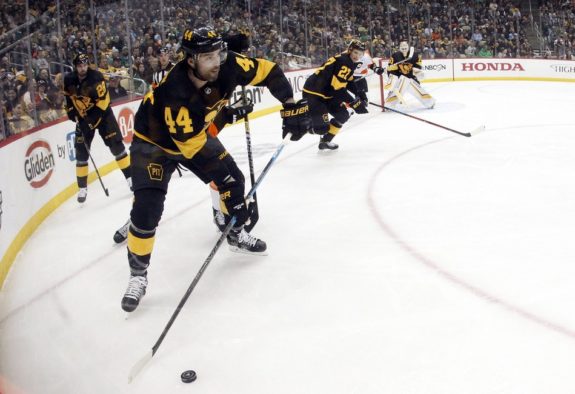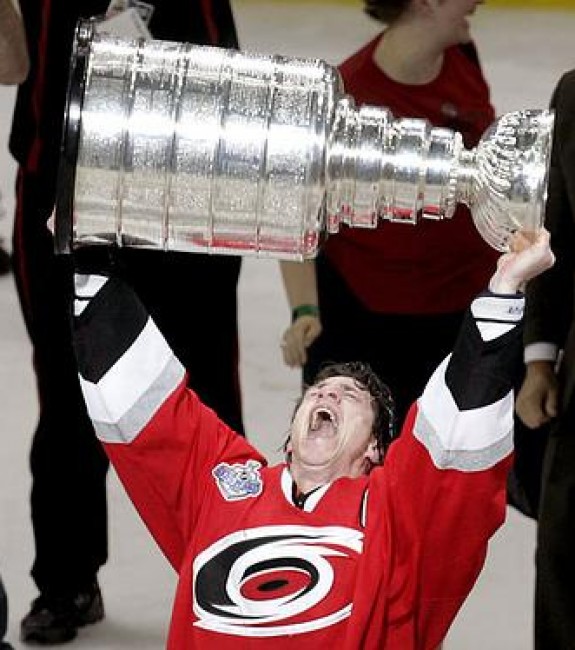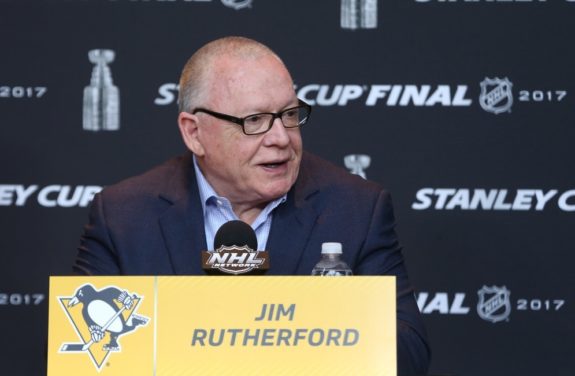Perhaps no hockey person had a more confusing summer than Pittsburgh Penguins general manager Jim Rutherford. As far as his present job, Pens fans correctly scratched their heads at his moves.
Rutherford’s Recent Moves
Six years, $21 million, and a modified no-trade clause given to Brandon Tanev. That’s a $2.35 million dollar raise in per season pay handed to an at-best depth scorer. His 29 points last season were a career-high and he’s 27.
Meanwhile, Phil Kessel’s point-a-game 2018-19 season was rewarded by being traded to the Arizona Coyotes for a significantly weaker offensive return in Alex Galchenyuk, prospect Pierre-Oliver Joseph, and $1.9 million worth of cap relief. Kessel’s defensive concerns were reasonable and his cantankerous nature is apparent, but the Penguins downgrade from 303 points in 328 regular-season games over four seasons and 56 points in 65 playoff games (and a player who never missed a game in four seasons) to a player whose career-high in playoff scoring is 4 points in 12 playoff games for the 2015 Montreal Canadiens. Galchenyuk has also not cracked the 60-point plateau (which Kessel only missed once in Pittsburgh with 59 points in 2015-16). As a result, the offense takes a serious hit entering the new season.
Jake Guentzel and Patric Hornqvist are still around, but Sidney Crosby and Evgeni Malkin are now left largely with younger and less talented offensive pieces to work with as they turn 32 and 33, respectively. Both legends were fantastic last season, as usual, but Rutherford gashed the scoring depth and replaced it with overpaid underachievers.
The Penguins’ defense situation is also a mess. Kris Letang, Brian Dumoulin, and Justin Schultz are still here. Letang is still elite and set the franchise record for most points in a career by a defenseman last season. Trouble is, he missed 17 games thanks to an injury sustained in the Stadium Series game against the Philadelphia Flyers. This adds to
Meanwhile, Erik Gudbranson and Jack Johnson, both regarded as poor blue line fits in the modern speed-based NHL, account for a combined $7.25 million cap hit. Neither has a no-trade clause, but the money situation for players loudly hated by modern analytics and so offensively impotent makes neither an attractive trade option. Also, promising defensive prospect and restricted free agent Marcus Pettersson is still unsigned with camp around the corner, and it’s likely someone will have to leave to make the room. His cap hit was under a $1 million last season and the Penguins cannot sign him until the books open up slightly. They currently have no room against the $81.5 million hard cap, currently within about a $100,000 of the limit.

Goaltending isn’t much better. Matt Murray only has one year left on his current contract before entering restricted free agency. He’s another candidate for a big pay raise after backstopping two successful Stanley Cup runs in his first two tries, and unless the Pens move major pieces, the goalie for whom Marc-Andre
In addition, Rutherford’s assistant GM, Bill Guerin, left for the GM position of the Minnesota Wild. A significant aid and franchise culture piece
Hall of Fame Honors Rutherford
Despite all that belly-aching, Rutherford was correctly rewarded for his career contributions to hockey with the highest honor possible: the Hall of Fame. His career as a general manager began in 1994 with the Hartford Whalers. He moved with the team to Carolina and crafted the Hurricanes into Eastern Conference champions in 2002. Most notably, he brought Ron Francis (the 2002 Lady Byng and King Clancy winner) back to the franchise to join Rod Brind’Amour and acquired game stealing goaltenders Arturs Irbe and Kevin Weekes.
He stayed on and drafted Eric Staal and Cam Ward. He added Doug Weight, Ray Whitney, and Mark Recchi to the Brind’Amour captained roster and Carolina brought Lord Stanley’s Cup to the Tar Heel State in 2006, a still nearly impossible accomplishment considering the previous chaos of the franchise and scant history of hockey in North Carolina.

Rutherford took the same job in Pittsburgh in 2014. He added Kessel, Nick Bonino, Carl Hagelin, Schultz, and Trevor Daley onto a core of Crosby, Malkin, and Letang. He installed Mike Sullivan as head coach and was rewarded with the first back-to-back Stanley Cup squad in almost 20 years. His Penguins will be remembered for winning consecutive Cups in the most chaotic age of the NHL. Player movement is more liberal, and while the best players predated Rutherford in Pittsburgh, the character of the team formed and succeeded due to his shrewd moves.
Rutherford deserves to enter the Hockey Hall of Fame as a builder on Nov. 18. He forged a forgotten franchise into a champion. He shrewdly found talent and put good coaches (Paul Maurice, Peter Laviolette, and Sullivan) in position to succeed with that talent. He helped two legendary players (Crosby and Malkin) cement their places in hockey history. He is the only GM in the post-expansion era to win Stanley Cups with multiple franchises. His legacy is rightly secure.
But he also deserves criticism for gutting a championship team of speed and skill, replacing it with poorly applied brute force, overpaying depth players, and trading away integral pieces of the core for relief from a terribly managed salary cap situation. Pens fans are correctly approaching the 2019-20
To be fair, Rutherford’s touch hasn’t completely evaporated. Trading Olli Maatta, a healthy scratch in the Islanders series, to the Chicago Blackhawks to shed salary and acquire young forward Dominik Kahun and flipping picks to the Edmonton Oilers for prospect John Marino to restock the farm are reminders of Rutherford’s talent eye and hockey mind. But there is much work to do for the Pens to forge another playoff run.

Trading Schultz around his modified no-trade clause? Finding someone to take Gudbranson or Johnson? Negotiating the cap to sign Pettersson? Extend Murray before the season starts to alleviate concerns for future offseasons? Summon Joseph and Kasper Bjorqkvist from the AHL Wilkes-Barre Penguins to play cheap roles? Use Zach Aston-Reese as a trading piece? Training camp opens in three weeks, on Sep. 13, to be exact. Rutherford has his work cut out. Much of it recovering from his own mistakes.